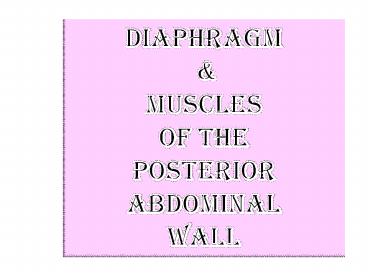DIAPHRAGM - PowerPoint PPT Presentation
1 / 17
Title:
DIAPHRAGM
Description:
* * It is a double domed, musculotendinous partition separating the thoracic & abdominal cavities. It is a chief muscle of inspiration It is formed of a peripheral ... – PowerPoint PPT presentation
Number of Views:1176
Avg rating:3.0/5.0
Title: DIAPHRAGM
1
DIAPHRAGM MUSCLES OF THE POSTERIOR ABDOMINAL
WALL
2
Diaphragm
It is a double domed, musculotendinous partition
separating the thoracic abdominal cavities. It
is a chief muscle of inspiration It is formed of
a peripheral muscular part centrally placed
(tendon)
3
Origin
4
Vertebral Origin
Crura Right crus From the bodies of upper 3
lumbar vertebrae (L1,L2 L3) their
intervertebral discs. Left crus From the
bodies of the upper 2 lumbar vertebrae (L1 L2 )
their intervertebral discs.
5
Vertebral origin
Lateral to crura the diaphragm arises from the
medial lateral arcuate ligaments
Lateral arcuate ligaments is the thickened
upper margin of the fascia covering the anterior
surface of quadratus lumborum muscle
Medial arcuate ligaments is the thickened upper
margin of the fascia covering the anterior
surface of psoas major muscle
6
(No Transcript)
7
Medial borders of the two crura connected by a
median arcuate ligaments which crosses over the
anterior surface of the aorta (T12)
Median arcuate ligament
8
INSERTION
It is inserted into a central tendon which is
shaped like 3 leaves (Trifle)
9
Shape of the diaphragm
The diaphragm has right left domes. The right
dome reaches as the upper border of 5th rib, The
left dome may reach the lower border of 5th
rib, NB The central tendon lies at the
xiphsternal junction,
10
X-RAY
11
MAJOR OPENINGS
It has 3 main openings (Voice Of Arabs)
Caval opening T8 Transmits IVC, right
phrenic nerve
Esophageal openingT10 Transmits Esophagus,
Vagi, Esophageal branches of left gastric
vessels Lymph vessels
Aortic opening T12 Transmits Aorta,
Thoracic duct Azygos vein
12
Other openings Splanchnic nerves, superior
epigastric vessels, left phrenic nerve,
Blood Supply of the diaphragm Superior
surface Pericardiacophrenic Musculophrenic
arteries (internal thoracic) Inferior surface
Inferior phrenic arteries (abdominal aorta)
13
Nerve Supply of the diaphragm Motor through
phrenic nerve (C3, 4 5) Sensory supply to the
central tendon (phrenic nerve) But the periphery
is from the lower five intercostal nerves
subcostal nerve.
14
Function
Muscle of Inspiration It is the chief muscle of
respiration In order to draw air into the
lungs, the diaphragm contracts, thus enlarging
the thoracic cavity and reducing intra-thoracic
pressure. When the diaphragm relaxes, air is
exhaled by elastic recoil of the lung. Muscle of
abdominal straining Micturation, defecation,
parturition Weight-lifting muscle Thoracoabdomin
al pump Caval lymphatic force increase by
increase in intra-abdominal pressure
15
Clinical Notes
Hiccup Involuntary spasmodic contraction of the
diaphragm Paralysis of the diaphragm Done to
give rest to lower lobe of the lung Penetrating
injury to the diaphragm Any penetrating wound
below the level of nipples should be suspected of
causing damage to the diaphragm Diaphragmatic
hernia May occur in middle age person due to
week musculature
16
muscle origin insertion nerve action
Psoas major 5 slips from the transverse processes, bodies and intervertebral discs of T12 the five lumbar vertebrae Lesser trochanter of the femur Lumbar plexus Flexes the thigh Flexes the vertebral column laterally Flexes the trunk on the thigh
Quadratus lamborum Ilio-lumbar ligament Inner lip of the iliac crest Tips of the transverse process of lower lumbar vertebrae. Medial half of the lower border of12th rib. Transverse process of upper lumbar vertebrae Lumbar plexus Laterally flexes the vertebral column It fixes the last rib in deep expiration
Iliacus Iliac fossa Lesser trochanter of the femur Femoral nerve Flexes the thigh on the trunk Flexes the trunk on the thigh as on sitting up from lying
17
Thank you
Thank you































